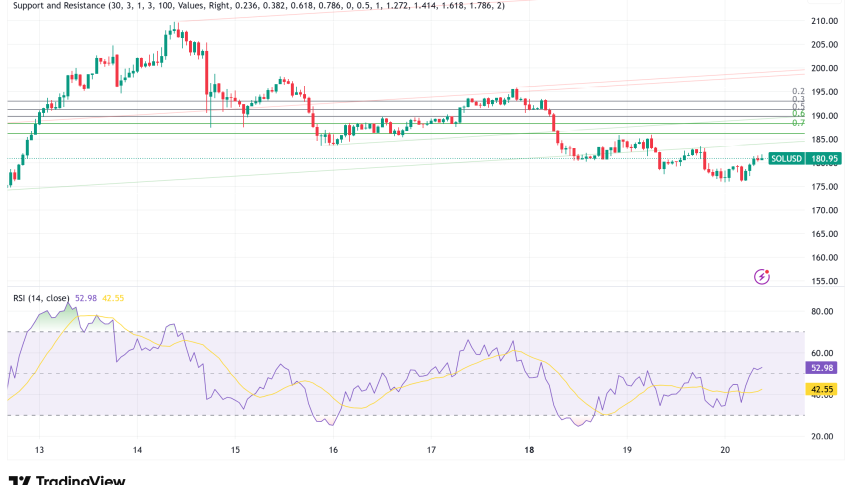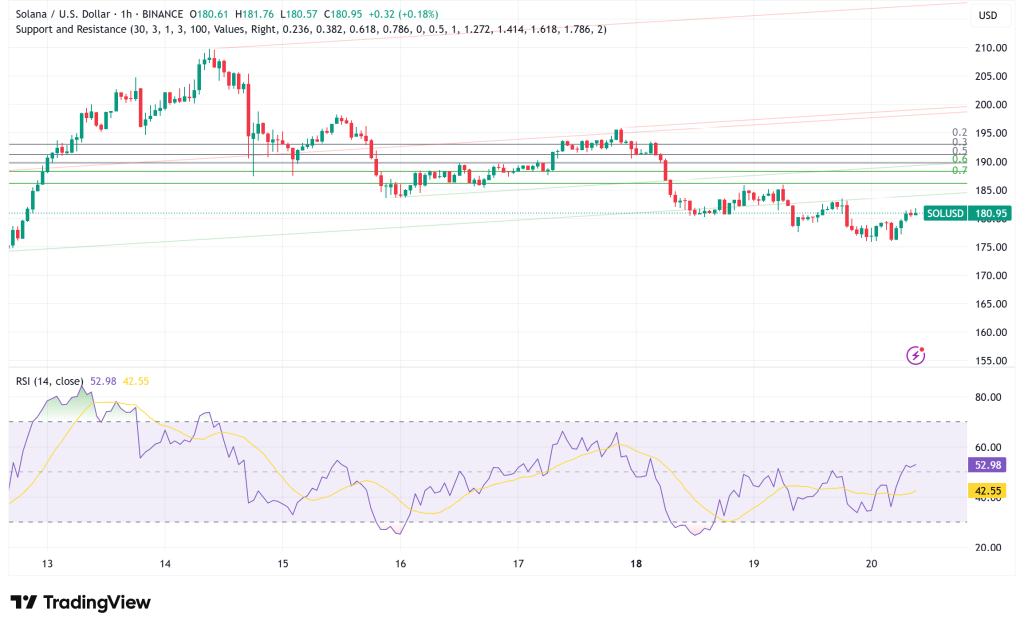Solana Bulls Eye $200 Recovery as DeFi Dominance and Institutional Interest Signal Strength

Quick overview
- Solana’s native token, SOL, has corrected 15.5% from a six-month high, raising concerns about a potential bearish reversal.
- Despite the recent dip, Solana’s DeFi ecosystem is thriving, with a Total Value Locked (TVL) of $12.1 billion and significant trading volume.
- Institutional interest in Solana is increasing, with open interest in SOL futures rising to $10.7 billion and $2.8 billion in assets under management in related ETFs.
- Technical and fundamental analyses suggest that SOL could recover to the $200 mark, supported by strong DeFi fundamentals and network efficiency.
After a strong run that saw it hit a six-month high of nearly $210, Solana’s native token, SOL, has experienced a sharp 15.5% correction, dropping to around $181. This pullback has raised concerns among some traders about a potential bearish reversal. However, a closer look at the network’s fundamentals, on-chain data, and institutional interest suggests that the current dip may be a temporary blip, and a recovery to the $200 level could be on the horizon.

Solana’s DeFi Leadership Strengthens Network Value Proposition
Solana SOL/USD is now the second-largest decentralized exchange (DEX) ecosystem, with a remarkable $111.5 billion in trade volume over the past 30 days. According to DefiLlama data, this performance was much better than the total Ethereum layer-2 networks, which made $93.1 billion, and BNB Chain, which made only $60 billion.
This week, the network’s Total Value Locked (TVL) hit $12.1 billion, a strong 20% rise over the past two months. This increase has made Solana the second-largest cryptocurrency, ahead of BNB Chain’s $7.8 billion TVL. Kamino, Jito, Jupiter, Sanctum, Raydium, and Marinade are just a few of the many big decentralized applications that have each reached a TVL of over $2 billion. This shows how mature and deep the ecosystem is.
Network Fee Growth Indicates Strong Fundamental Health
The ability to make money through network fees is another positive sign for SOL’s future. In the last 30 days, Solana made $35.6 million in fees, which is 22% more than the month before. Ethereum stayed in the lead with $41.4 million, but it dropped 7% during the same time period. It’s especially impressive that Solana is the third-largest blockchain by network fees, since Ethereum has a much larger base of smart contract deposits.
The network has a competitive edge because it has cheap fees and a smooth user experience. This means that users don’t need to deal with complicated bridges and layer-2 solutions that can cause problems in other ecosystems.
Institutional Participation Accelerates Across Multiple Fronts
Institutional interest in Solana is growing in a number of different types of investments. Open interest in SOL futures has grown from $6.9 billion two months ago to $10.7 billion presently. This is more than XRP futures, even though XRP has a market valuation that is 81% higher. This expansion shows that more institutions are becoming involved and that people are confident that it will be adopted in the long term.
There are now $2.8 billion in assets under management in exchange-traded vehicles that focus on Solana. Once the United States approves Solana spot ETFs, the network’s attractive 7.3% native staking yield might lead to a lot of interest. Bloomberg experts say that there is a 90% or higher chance that the SEC will approve it by the end of the year. This could be a big reason for the stock to go up.
SOL/USD Technical Analysis Points to $200 Recovery Target
SOL/USD
Even though there has been a lot of negative sentiment since the price fell from $209.80, both technical and fundamental analysis show that SOL is still in a good position to return near the $200 mark. The convergence of DeFi leadership, rising TVL, faster fee growth, and more institutional exposure all point to a long-term bearish turnaround.
Recent changes in the ecosystem, such 1inch’s availability of native cross-chain swaps across Solana and EVM networks that don’t need bridges, make the network even more useful and easy to use. This new idea solves the problem of liquidity fragmentation and makes Solana a more important DeFi center.
Solana Price Prediction: Mixed Q2 Performance Shows Efficiency Gains Despite Revenue Decline
The total application revenue fell 44.2% to $576.4 million in the second quarter of 2025. However, Solana’s application revenue capture ratio rose dramatically from 126.5% to 211.6%. This increase in efficiency means that applications make $211.60 for every $100 spent on transaction fees, which shows that the economic model is more sustainable.
Recent price drops may not be a trend reversal, but rather a temporary correction because of solid DeFi fundamentals, increased institutional interest, improving network efficiency, and technical support levels. Traders who became pessimistic after the recent drop may have acted too soon, as the $200 price objective is still possible in the foreseeable future.